Explore the beauty of Trees That Start With ‘R’. From majestic Redwoods to elegant River Birches, discover their unique features, benefits and how these remarkable trees can enhance your landscape.
Trees are nature’s silent giants, standing tall and proud in our forests, parks and gardens. They clean our air, provide homes for wildlife and add beauty to our world. Today, we’re going to explore some fascinating trees that all start with the letter ‘R’. These trees are not just pretty to look at – they’re also important parts of our ecosystems and have many uses. Let’s dive in and discover these wonderful ‘R’ trees!
1. Redwood

Here’s a chart with information about the Redwood tree (Sequoia sempervirens):
| Category | Information |
|---|---|
| Botanical Name | Sequoia sempervirens |
| Common Name | Redwood, Coast Redwood |
| Plant Type | Evergreen Tree |
| Hardiness Zone | USDA Zones 7-10 |
| Sun Exposure | Full sun to partial shade |
| Soil Type | Well-draining, rich, loamy soil |
| Watering | Moderate; prefers moist conditions |
| Growth Habit | Tall, upright |
| Height/Spread | 200-300 feet tall, 20-30 feet wide |
| Special Features | Tallest trees in the world, thick reddish-brown bark, needle-like leaves, long lifespan, valuable timber, provides habitat for wildlife |
When we think of trees that start with ‘R’, the mighty Redwood often comes to mind first. These giants of the forest are some of the tallest trees in the world.
Key Features:
- Extremely tall, often over 300 feet
- Reddish-brown bark that’s very thick
- Needles instead of leaves
- Can live for thousands of years
Benefits:
- Store huge amounts of carbon, helping fight climate change
- Provide homes for many animals
- Create unique, awe-inspiring forests
Growing Tips:
- Need lots of space to grow
- Like cool, humid climates
- Prefer well-draining, slightly acidic soil
While most of us can’t grow redwoods in our backyards, visiting a redwood forest is an unforgettable experience. These trees remind us of nature’s incredible power and beauty.
2. Red Maple
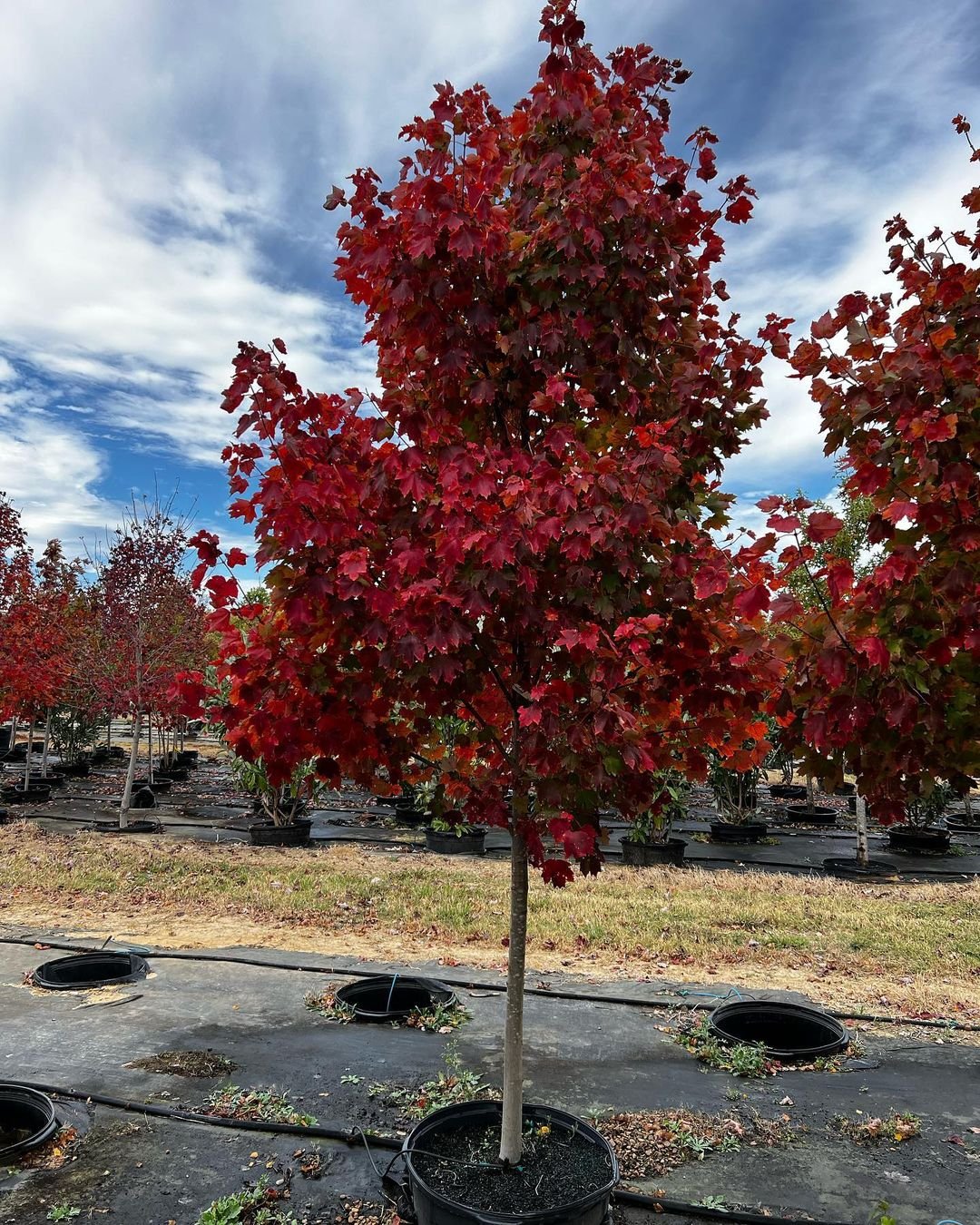
Here’s a chart with information about the Red Maple (Acer rubrum):
| Category | Information |
|---|---|
| Botanical Name | Acer rubrum |
| Common Name | Red Maple, Scarlet Maple, Swamp Maple |
| Plant Type | Deciduous Tree |
| Hardiness Zone | USDA Zones 3-9 |
| Sun Exposure | Full sun to partial shade |
| Soil Type | Well-draining, adaptable to various soil types, prefers moist soil |
| Watering | Moderate; prefers moist conditions |
| Growth Habit | Upright, rounded canopy |
| Height/Spread | 40-60 feet tall, 30-50 feet wide |
| Special Features | Brilliant red fall foliage, adaptable to various soil types, fast-growing, provides shade, attractive bark, used in landscaping and urban settings |
The Red Maple is a popular tree known for its beautiful fall colors.
Key Features:
- Leaves turn bright red in fall
- Red flowers in spring
- Fast-growing
Benefits:
- Provides great fall color
- Offers shade in summer
- Supports wildlife with seeds and shelter
Growing Tips:
- Adaptable to many soil types
- Prefers full sun to partial shade
- Tolerates both wet and dry conditions
Red Maples are great choices for yards and parks. They’re hardy, fast-growing and offer beautiful colors throughout the year.
3. River Birch
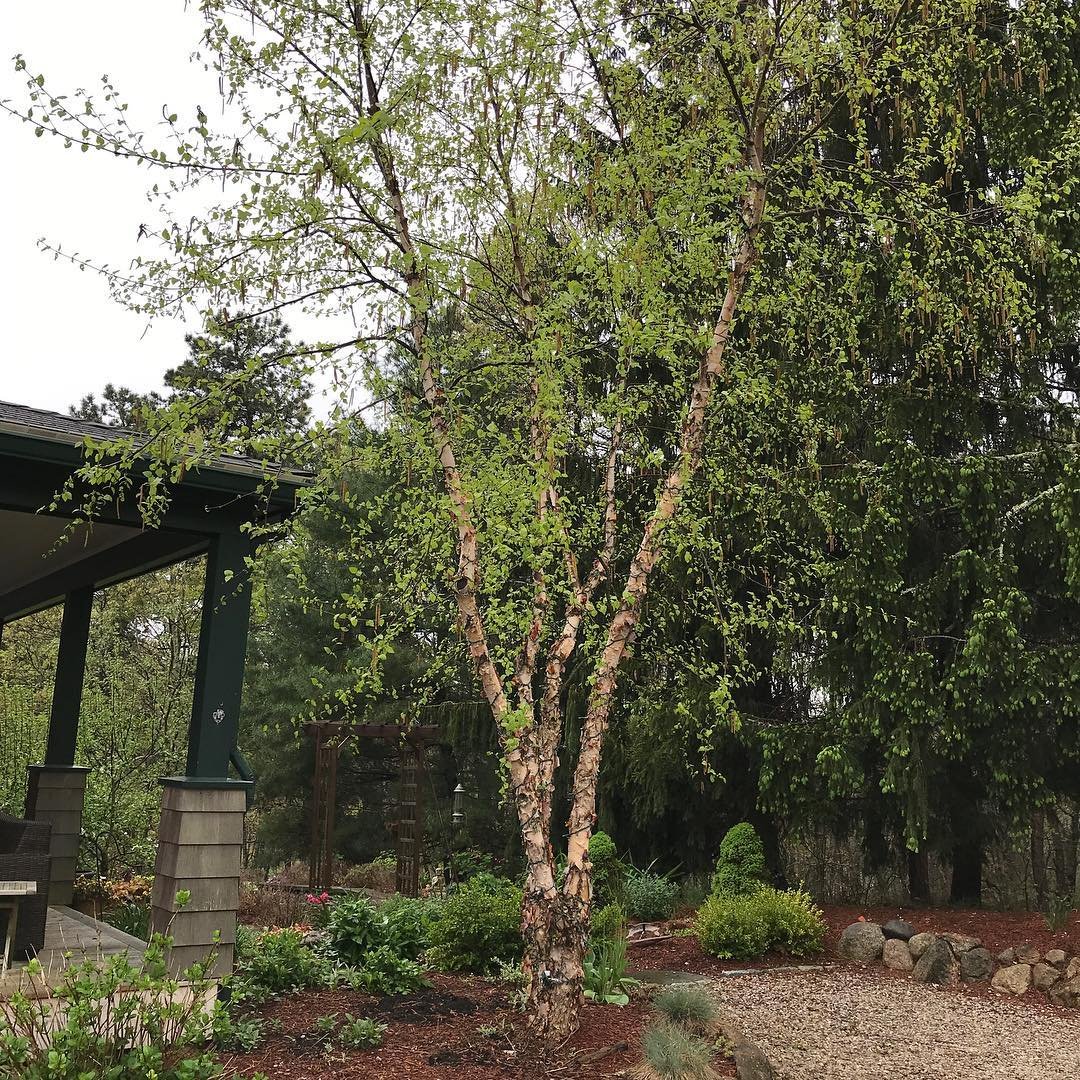
Here’s a chart with information about the River Birch (Betula nigra):
| Category | Information |
|---|---|
| Botanical Name | Betula nigra |
| Common Name | River Birch |
| Plant Type | Deciduous Tree |
| Hardiness Zone | USDA Zones 4-9 |
| Sun Exposure | Full sun to partial shade |
| Soil Type | Well-draining, prefers moist, acidic soil |
| Watering | Moderate to high; prefers consistently moist conditions |
| Growth Habit | Upright, multi-stemmed |
| Height/Spread | 40-70 feet tall, 40-60 feet wide |
The River Birch is known for its unique, peeling bark and graceful shape.
Key Features:
- Peeling, papery bark
- Diamond-shaped leaves
- Often has multiple trunks
Benefits:
- Resistant to many pests and diseases
- Helps prevent soil erosion near water
- Provides habitat for birds
Growing Tips:
- Likes moist soil
- Prefers full sun to partial shade
- Tolerates both flooding and drought
River Birches are excellent choices for areas near water or in yards with poor drainage. Their unique bark adds interest to the landscape year-round.
4. Redbud
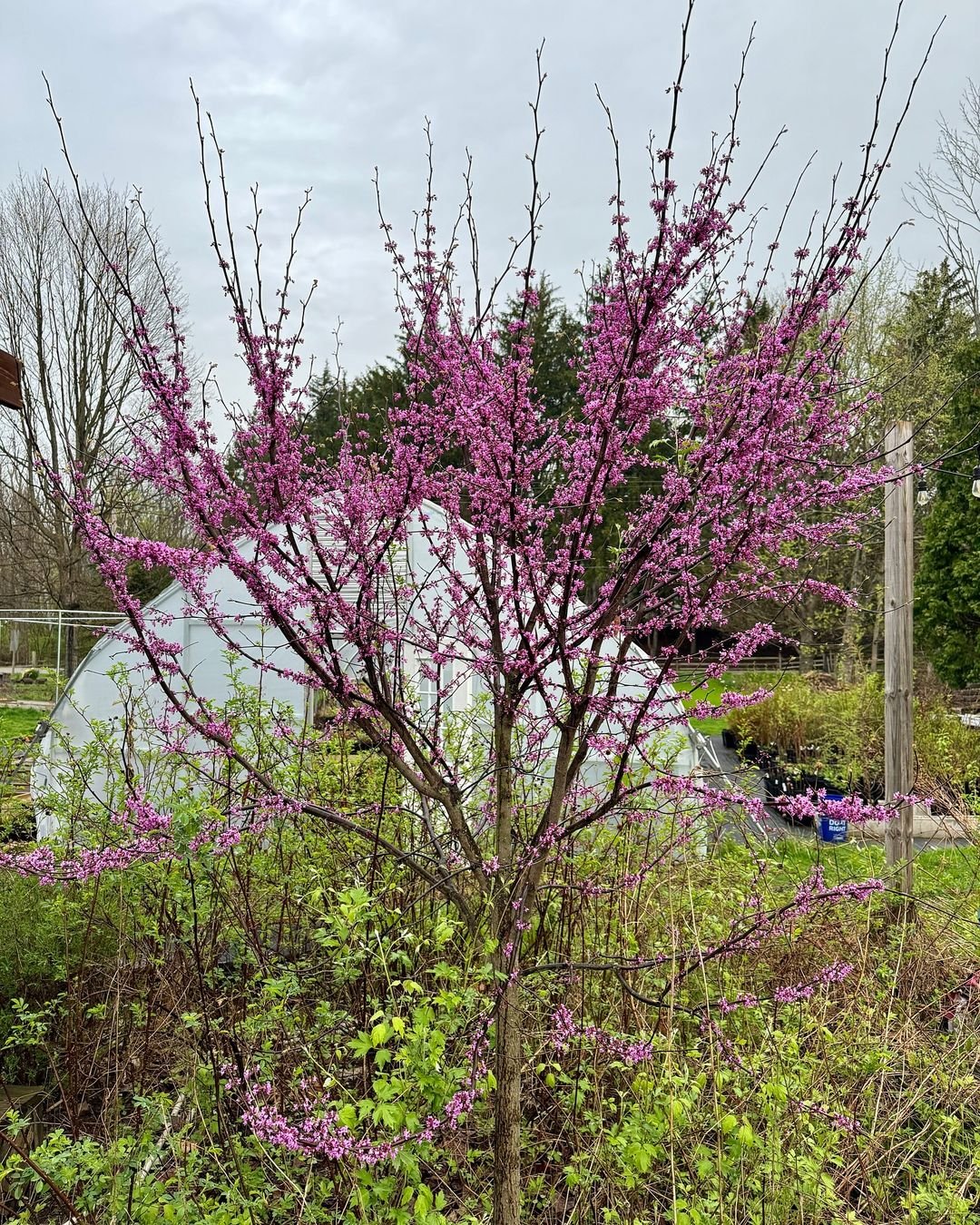
Here’s a chart with information about the Redbud (Cercis canadensis):
| Category | Information |
|---|---|
| Botanical Name | Cercis canadensis |
| Common Name | Redbud, Eastern Redbud |
| Plant Type | Deciduous Tree |
| Hardiness Zone | USDA Zones 4-9 |
| Sun Exposure | Full sun to partial shade |
| Soil Type | Well-draining, adaptable to various soil types |
| Watering | Moderate |
| Growth Habit | Upright, spreading, rounded canopy |
| Height/Spread | 20-30 feet tall, 25-35 feet wide |
| Special Features | Heart-shaped leaves, vibrant pink to purple flowers in early spring, attractive fall color, drought tolerant once established, wildlife friendly, used in ornamental landscaping |
The Redbud is a small tree loved for its early spring flowers.
Key Features:
- Pink or purple flowers in early spring
- Heart-shaped leaves
- Often has a spreading, multi-trunked form
Benefits:
- Early source of nectar for pollinators
- Beautiful spring display
- Tolerant of urban conditions
Growing Tips:
- Prefers well-draining soil
- Does best in full sun to partial shade
- Needs protection from strong winds
Redbuds are perfect for small yards or as understory trees in larger landscapes. Their early spring flowers are a welcome sight after winter.
5. Rowan
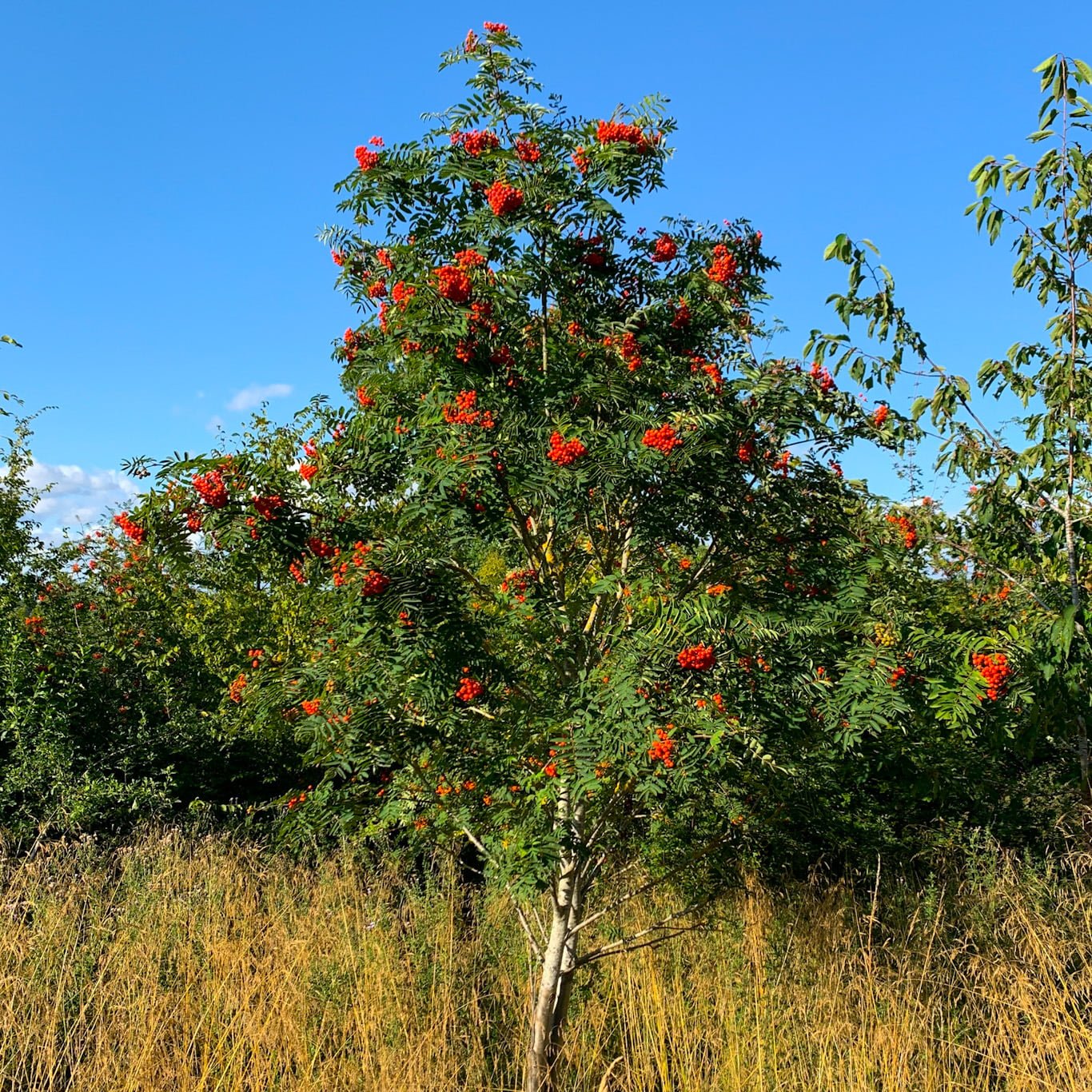
Here’s a chart with information about the Rowan tree (Sorbus aucuparia):
| Category | Information |
|---|---|
| Botanical Name | Sorbus aucuparia |
| Common Name | Rowan, Mountain Ash |
| Plant Type | Deciduous Tree |
| Hardiness Zone | USDA Zones 3-7 |
| Sun Exposure | Full sun to partial shade |
| Soil Type | Well-draining, acidic to neutral soil |
| Watering | Moderate |
| Growth Habit | Upright, rounded canopy |
| Height/Spread | 20-40 feet tall, 15-25 feet wide |
| Special Features | Clusters of white flowers in spring, bright red/orange berries in fall, pinnate leaves with attractive fall color, wildlife friendly, used in landscaping for ornamental and cultural significance |
Also known as Mountain Ash, the Rowan is a beautiful tree with year-round interest.
Key Features:
- White flowers in spring
- Red berries in fall and winter
- Compound leaves that turn orange in fall
Benefits:
- Provides food for birds
- Adds color to the landscape in multiple seasons
- Has a long history in folklore and traditional medicine
Growing Tips:
- Prefers cool climates
- Needs well-draining soil
- Does best in full sun
Rowans are great choices for cooler climates. Their berries provide food for birds in winter and add a pop of color to the landscape.
6. Royal Poinciana

Here’s a chart with information about the Royal Poinciana (Delonix regia):
| Category | Information |
|---|---|
| Botanical Name | Delonix regia |
| Common Name | Royal Poinciana, Flamboyant Tree |
| Plant Type | Deciduous Tree |
| Hardiness Zone | USDA Zones 10-12 |
| Sun Exposure | Full sun |
| Soil Type | Well-draining, sandy or loamy soil |
| Watering | Moderate |
| Growth Habit | Spreading, umbrella-like canopy |
| Height/Spread | 30-40 feet tall, 30-40 feet wide (can vary widely in ideal conditions) |
| Special Features | Flamboyant display of red or orange flowers in late spring to early summer, fern-like foliage, drought tolerant once established, provides filtered shade |
The Royal Poinciana, also known as Flamboyant, is a stunning tropical tree.
Key Features:
- Large, bright red flowers
- Fern-like leaves
- Wide, umbrella-shaped canopy
Benefits:
- Provides beautiful tropical flowers
- Offers shade in hot climates
- Attracts pollinators
Growing Tips:
- Needs warm, tropical climates
- Prefers well-draining soil
- Does best in full sun
While not suitable for cold climates, Royal Poincianas are showstoppers in tropical and subtropical areas. Their bright flowers are truly spectacular.
7. Red Pine
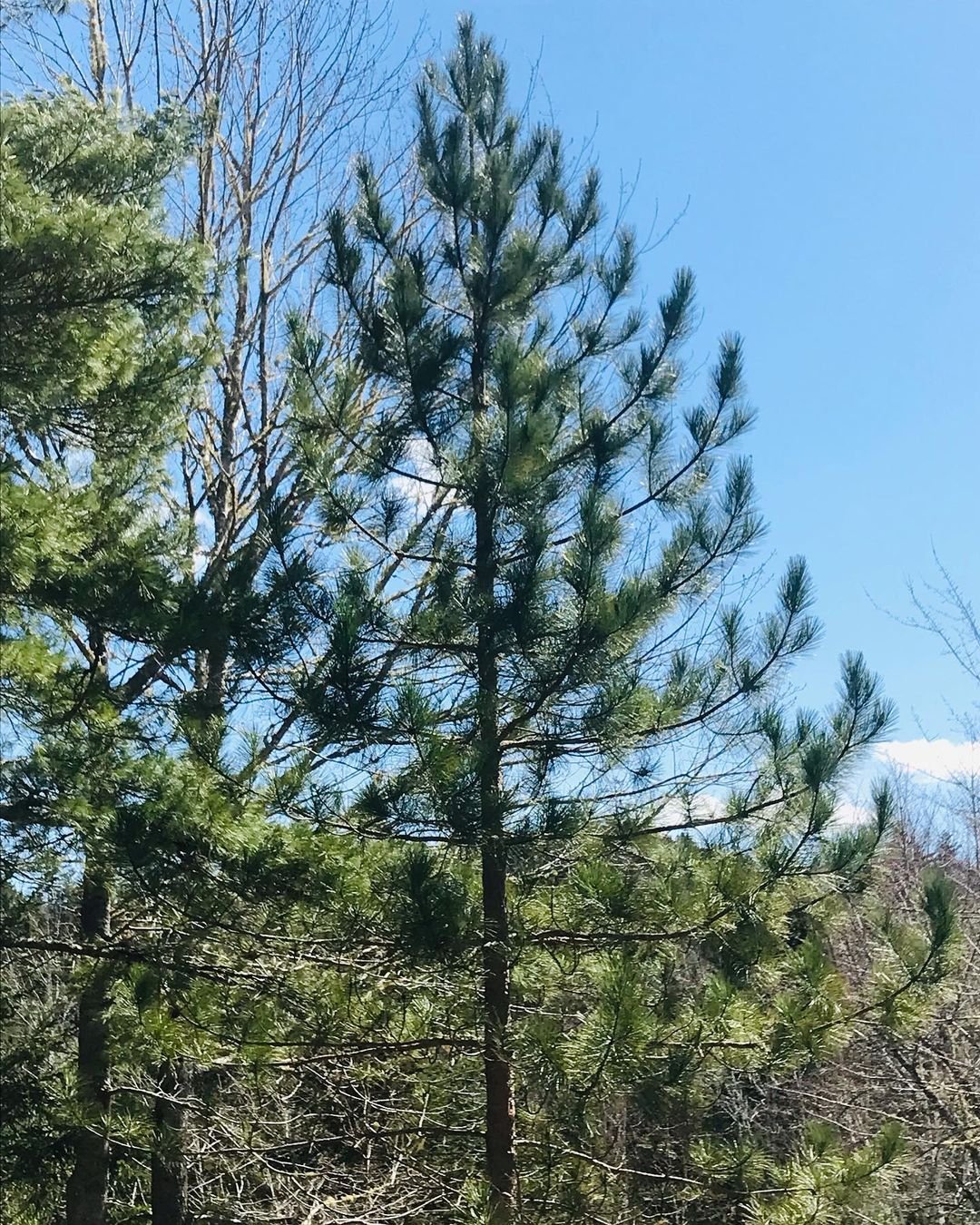
Here’s a chart with information about the Red Pine (Pinus resinosa):
| Category | Information |
|---|---|
| Botanical Name | Pinus resinosa |
| Common Name | Red Pine |
| Plant Type | Evergreen Tree |
| Hardiness Zone | USDA Zones 3-7 |
| Sun Exposure | Full sun |
| Soil Type | Well-draining, acidic to neutral soil |
| Watering | Low to moderate |
| Growth Habit | Upright, pyramidal |
| Height/Spread | 50-80 feet tall, 20-40 feet wide |
| Special Features | Reddish-brown bark, needle-like green foliage, long needles in bundles of two, tolerant of dry and poor soils, used in reforestation, timber production, and landscaping |
The Red Pine, also known as Norway Pine, is a tall, straight pine tree.
Key Features:
- Long needles in pairs
- Reddish-brown bark
- Conical shape when young, rounded crown when mature
Benefits:
- Important for timber production
- Provides habitat for wildlife
- Good for reforestation projects
Growing Tips:
- Prefers sandy, well-draining soil
- Needs full sun
- Tolerates cold climates well
Red Pines are important trees in their native range. They’re often used in reforestation projects and provide valuable habitat for wildlife.
8. Russian Olive

Here’s a chart with information about the Russian Olive tree (Elaeagnus angustifolia):
| Category | Information |
|---|---|
| Botanical Name | Elaeagnus angustifolia |
| Common Name | Russian Olive |
| Plant Type | Deciduous Tree |
| Hardiness Zone | USDA Zones 3-9 |
| Sun Exposure | Full sun |
| Soil Type | Well-draining, tolerant of various soil types |
| Watering | Low to moderate |
| Growth Habit | Upright, spreading |
| Height/Spread | 15-30 feet tall, 15-20 feet wide |
| Special Features | Silver-green foliage, small fragrant yellow flowers in spring, silver berries in summer/fall, drought tolerant, tolerant of poor soil conditions, invasive potential in some regions |
The Russian Olive is a small tree or large shrub known for its silvery leaves.
Key Features:
- Silvery-gray leaves
- Fragrant flowers in spring
- Small, olive-like fruits
Benefits:
- Tolerant of poor soils and drought
- Provides food for wildlife
- Can be used as a windbreak
Growing Tips:
- Adaptable to many soil types
- Prefers full sun
- Very drought-tolerant once established
While Russian Olives are beautiful and tough, it’s important to note that they’re considered invasive in some areas. Check local regulations before planting.
9. Red Alder

Here’s a chart with information about the Red Alder (Alnus rubra):
| Category | Information |
|---|---|
| Botanical Name | Alnus rubra |
| Common Name | Red Alder |
| Plant Type | Deciduous Tree |
| Hardiness Zone | USDA Zones 7-9 |
| Sun Exposure | Full sun to partial shade |
| Soil Type | Moist, well-draining |
| Watering | High |
| Growth Habit | Fast-growing, conical to oval |
| Height/Spread | 50-100 feet tall, 20-40 feet wide |
| Special Features | Smooth gray bark, dark green leaves, nitrogen-fixing roots, important for riparian zones and stream restoration, used in furniture and paper production |
The Red Alder is a fast-growing tree native to the Pacific Northwest.
Key Features:
- Smooth, light gray bark
- Serrated, dark green leaves
- Produces small, cone-like fruits
Benefits:
- Fixes nitrogen in the soil
- Provides food and habitat for wildlife
- Used in furniture making and smoking foods
Growing Tips:
- Prefers moist soil
- Does best in full sun to partial shade
- Tolerates poor soil conditions
Red Alders are important pioneer species, often growing in disturbed areas and improving soil conditions for other plants.
10. Rubber Tree
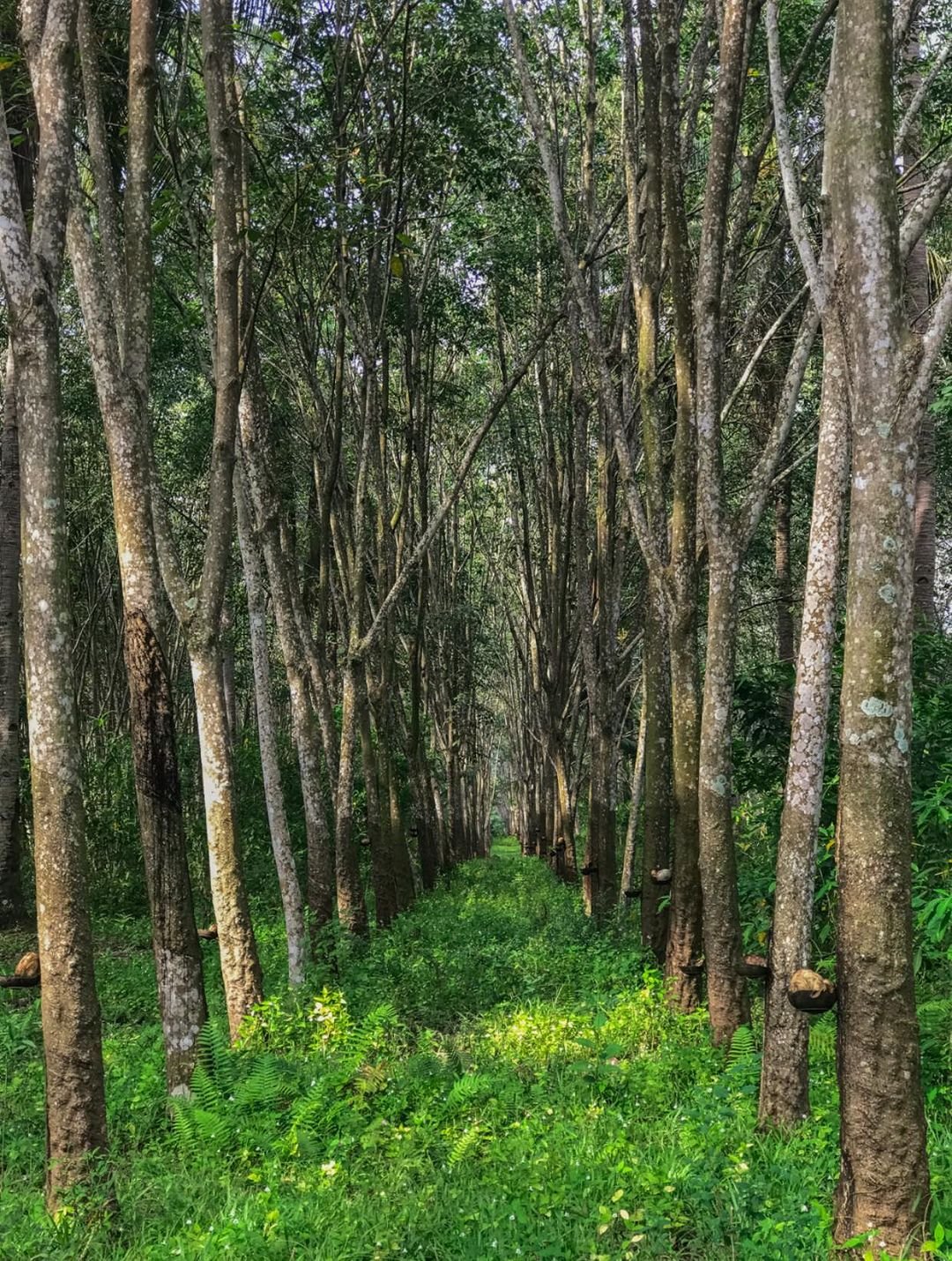
Here’s a chart with information about the Rubber Tree (Hevea brasiliensis):
| Category | Information |
|---|---|
| Botanical Name | Hevea brasiliensis |
| Common Name | Rubber Tree |
| Plant Type | Evergreen Tree |
| Hardiness Zone | USDA Zones 10-12 |
| Sun Exposure | Full sun |
| Soil Type | Well-draining, sandy or loamy soil |
| Watering | Moderate; prefers consistently moist soil |
| Growth Habit | Upright, tall |
| Height/Spread | 50-100 feet tall, 25-35 feet wide (depending on age and conditions) |
| Special Features | Latex production for rubber, commercial significance, large leaves, tropical origin, requires specific environmental conditions for latex production |
The Rubber Tree is known for producing natural rubber.
Key Features:
- Large, glossy leaves
- Smooth, gray bark
- Produces a milky latex sap
Benefits:
- Source of natural rubber
- Can be grown as an indoor plant when young
- Important for many indigenous communities
Growing Tips:
- Needs warm, humid conditions
- Prefers well-draining soil
- Does best in partial shade when young, full sun when mature
While most of us won’t be growing rubber trees for commercial production, they can make interesting indoor plants when young.
11. Red Cedar
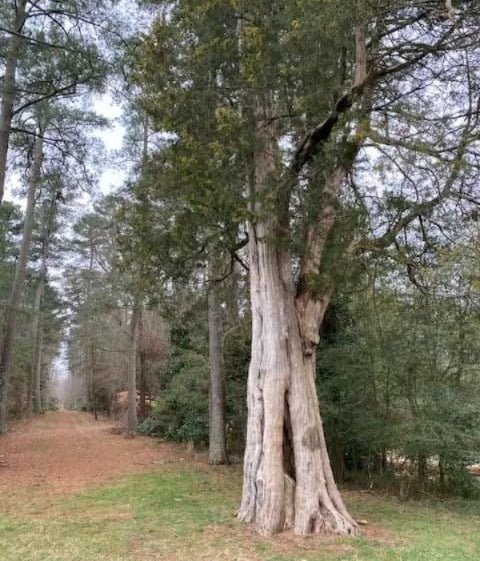
Here’s a chart with information about the Red Cedar tree (Juniperus virginiana):
| Category | Information |
|---|---|
| Botanical Name | Juniperus virginiana |
| Common Name | Red Cedar, Eastern Red Cedar |
| Plant Type | Evergreen Tree |
| Hardiness Zone | USDA Zones 2-9 |
| Sun Exposure | Full sun to partial shade |
| Soil Type | Well-draining, adaptable to various soil types |
| Watering | Low to moderate |
| Growth Habit | Conical to columnar |
| Height/Spread | 40-60 feet tall, 8-20 feet wide |
| Special Features | Reddish-brown bark, scale-like foliage, aromatic wood, attracts wildlife, used for timber, cedarwood oil production |
The Red Cedar is an aromatic evergreen tree native to North America.
Key Features:
- Scale-like leaves
- Reddish-brown, peeling bark
- Blue, berry-like cones
Benefits:
- Wood is resistant to decay
- Provides winter shelter for wildlife
- Used in essential oils and woodworking
Growing Tips:
- Adaptable to many soil types
- Prefers full sun
- Very drought-tolerant once established
Red Cedars are tough, adaptable trees that can thrive in many conditions. Their aromatic wood is prized for its scent and durability.
12. Rhododendron
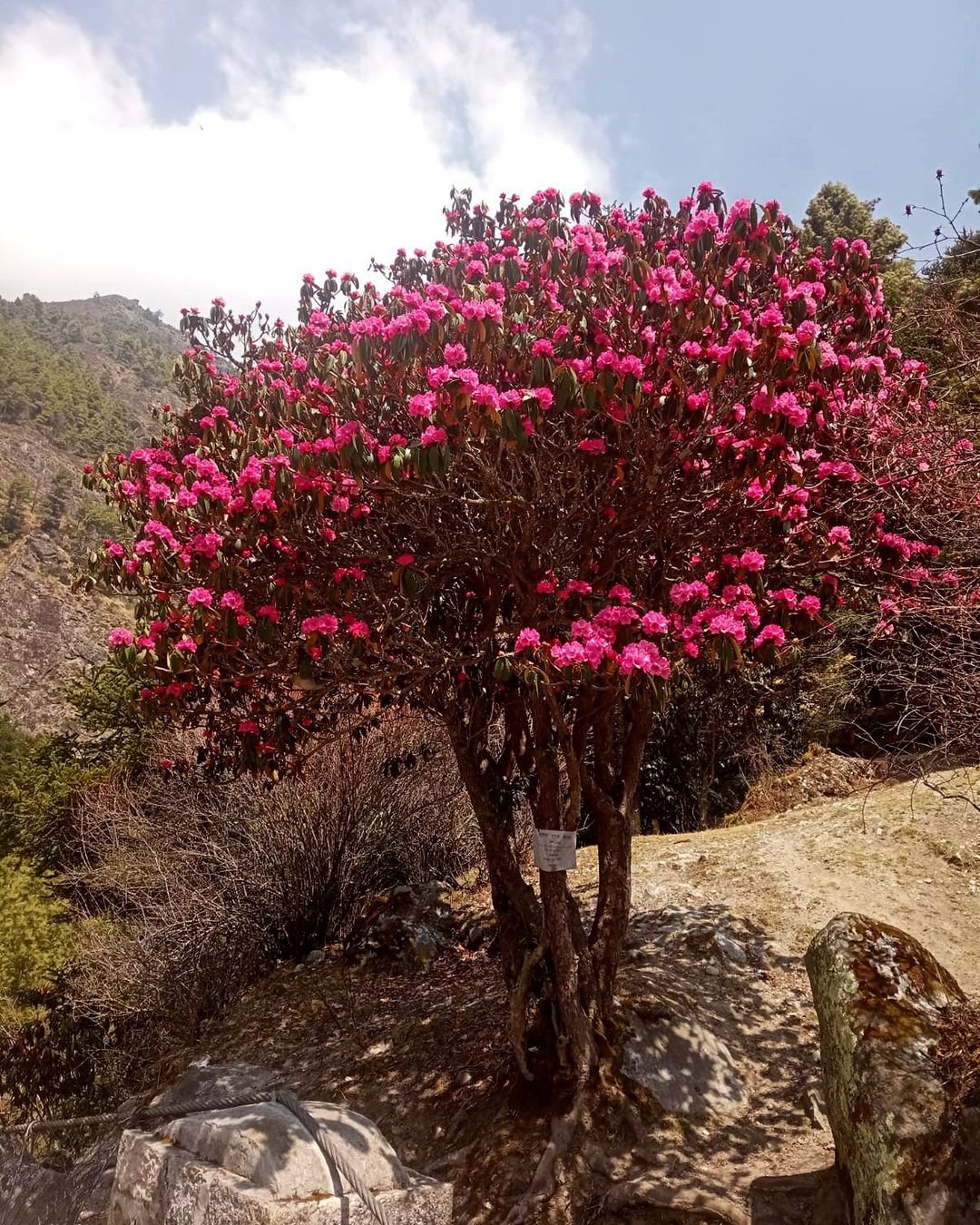
Here’s a chart with information about Rhododendrons:
| Category | Information |
|---|---|
| Botanical Name | Rhododendron spp. |
| Common Name | Rhododendron |
| Plant Type | Evergreen or deciduous shrub |
| Hardiness Zone | USDA Zones 4-9, depending on species |
| Sun Exposure | Part shade to full shade |
| Soil Type | Well-draining, acidic |
| Watering | Moderate |
| Growth Habit | Upright, rounded, varies by species |
| Height/Spread | Varies widely by species |
| Special Features | Showy clusters of flowers in various colors, evergreen or deciduous foliage, prefers cool and moist climates, toxic if ingested |
While technically more of a shrub, some Rhododendron species can grow into small trees.
Key Features:
- Large, showy flowers in spring
- Evergreen leaves in most species
- Often have a rounded, multi-stemmed form
Benefits:
- Provide beautiful spring flowers
- Evergreen species offer year-round interest
- Many varieties to choose from
Growing Tips:
- Prefer acidic, well-draining soil
- Do best in partial shade
- Need protection from strong winds
Rhododendrons can add a burst of color to shady areas in your garden. With proper care, they can live for many years, getting more beautiful with age.
Trees that start with ‘R’ are a diverse and fascinating group. From the towering Redwoods that reach for the sky to the colorful Redbuds that brighten our spring days, these trees offer something for everyone. Whether you’re looking to add shade, color or just beauty to your landscape, consider one of these ‘R’ trees.
Remember, when planting any tree:
- Choose a species that’s well-suited to your climate and soil conditions
- Give the tree enough space to grow to its full size
- Provide proper care, especially in the first few years after planting
Trees are more than just plants – they’re living legacies that can last for generations. By planting and caring for trees, we’re not just improving our own surroundings, but also contributing to a healthier planet for future generations.
Whether you’re planting a mighty Redwood that will outlive us all or a small Redbud to brighten your yard, every tree makes a difference. They clean our air, provide homes for wildlife and add beauty to our world. So why not consider adding one of these beautiful ‘R’ trees to your landscape? Your future self and the planet – will thank you!
Happy planting and may your ‘R’ trees grow strong and beautiful for years to come!
Pingback: The Majestic White Oak Tree: History, Benefits and Care